In This Issue:
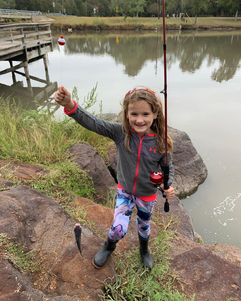
by Jason True, TPWD Palmetto State Park Asst. Superintendent
How many days a year can you fish Texas waters? 365!
Start planning NOW to maximize your 2023 state park fishing list! Whether you’re chasing redfish in the bays around Goose Island or Guadalupe bass at Blanco, our state parks are fishing destinations in every season. With so many diverse fishing opportunities, you can catch an amazing variety of species.
The first Rio Grande cichlid I ever caught was at South Llano River State Park on a family vacation. The thrill of holding and releasing that unique native fish made me want to catch every species. Through the years, I spent my free time traveling and camping in Texas state parks (I’m now Palmetto State Park's assistant superintendent), targeting the array of fish that call our state waters home. Adding each one to my list was truly satisfying.
|
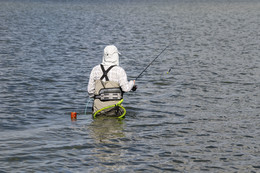
I also love birding. When I participated in a birding "Big Year" (a personal challenge to see as many bird species as possible in one year), I found inspiration. Why can’t we do that for fishing? That was the genesis of the "Texas State Parks Fishing Challenge". So simple and fun, just catch as many different species as you can from any of the Texas state parks in one year.
How to participate:
- Catch a fish.
- Take a picture (please follow safe fish handling procedures).
- Post on social media with #TXStateParksFishingChallenge.
The first "Big Year" for fish will start Jan. 1, so start planning your 2023 camping trips to Texas state parks. For new parks to fish and new species to target, visit tpwd.texas.gov/wheretofish to find available species and a current fishing report. Remember that no fishing license is required when fishing inside Texas state parks.
(Photo credits: Top - Jan Bates, TPWD Angler Edu Certified Instructor. Bottom -Chase Fountain, TPWD.)
|
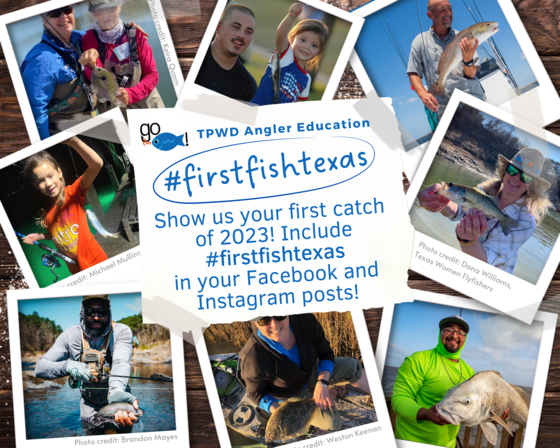
If you missed the social media post about TPWD Angler Education's "First Fish Texas" campaign, where you share your first fish caught in 2023 by posting it on Facebook and tagging it for Instagram, you can extend the fishing fun all year round and accept Jason's challenge for a "Big Year" for fishing! Life's Better Outside!
Back to Top
by Adam Comer, TPWD Angler Edu Training Specialist
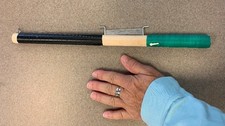
You know the ole adage…love can be found in unexpected places.
At the September 2022 Aquatic Resources Education Association (AREA) Conference in Rapid City, South Dakota, an unlikely union was forged between the jiggle stick and microfishing. AREA is a national professional organization for aquatic educators and angler R3 programs, created to foster and promote aquatic education.
The stage is set, let’s meet our characters…
Unless you’ve spent some time ice fishing, you probably would appreciate a jiggle stick explanation. A jiggle stick is used in ice fishing and consists of a short rod (18-inch wooden dowel) with fishing line wrapped around square bend screws and an eye screw near the tip to guide the line. The “jiggle” refers to moving the bait up and down while fishing. South Dakota gets its fair share of frigid cold weather and icefishing is part of the seasonal way of life.
Microfishing is the pursuit of catching smaller fish with a pole and line. The fish you’ve heard of; often referred to as minnows or baitfish, are pursued as prized and challenging catches with tiny hooks and tackle. Microfishing rigs can be as simple as a dowel or stick with line and tackle to handmade artisan portable fishing poles made in Japan. You might check out our YouTube presentation to learn more.
So, how did the unlikely pairing come together? Your fellow Texas angler educators, Adam Comer with Texas Parks & Wildlife and Michael Scherer with Fishing’s Future planned to lead a hands-on session on microfishing at the conference. Instead of packing and shipping 20 microfishing rigs to South Dakota for participants, the hope was to find an accessible alternative to use. While prepping for the conference, Keira Quam and the South Dakota staff discovered a likely alternative and it was love at first sight.
|
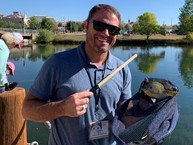
The jiggle stick is portable, durable, inexpensive, simple to assemble and manages line well. Just the rig you need to get started with microfishing. With a quick swap of the hooks and leaders to a smaller size, the jiggle sticks were ready to use to micro fish during the session.
As you can see from the picture of Aaron of Nevada Dept of Wildlife to the right, the jiggle stick was a success and we can’t wait to marry the two in future microfishing opportunities.
(Photo credits: top - Keira Quam, TPWD. Bottom - Adam Comer, TPWD)
|
Back to Top
By Mike McCorkhill, TPWD Angler Edu Certified Instructor
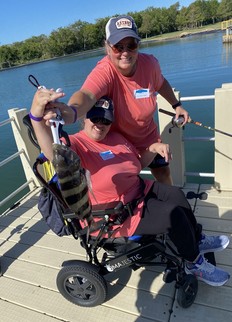
I’ve been a Texas Parks and Wildlife volunteer for about 9 years. One of the best attributes of TPWD as a force for education, is the organization’s almost incidental act of building bridges with other organizations.
The volunteer spirit I have, is heavily influenced by outreach aimed at helping everyone. When the opportunity arrived to participate in a Special Olympics Fishing Tournament, at Sea Center Texas (Lake Jackson) it was too good to pass up.
I participated in a Special Olympics event, several years ago and was so excited to see these athletes compete with such abandon. I expected the same experience working a fishing tourney and was not disappointed. These athletes are so positive and put their whole hearts into whatever they are doing.
While each of the athletes are differently abled, it was their acts of lifting each other up and their encouraging words that really made the event so much fun. They are not competing against each other, only against their own expectations of what they can accomplish.
Very few of the athletes caught fish this day. For some, the highlight was taking time from fishing and eating a snack. However, they were all engaged in the process, smiling, and each person brought a unique perspective to the event.
At first, I was disappointed that more athletes didn’t catch fish, but then I realized, the goal wasn’t about catching fish, it was about being in the moment and experiencing the journey. I could use a lot more of this type of joy.
If you have not experienced volunteering for Special Olympics, I suggest you check it out. There was some discussion of holding a similar event in North Texas. If there is an opportunity to do so, I would encourage you to participate. I’ll be there. Oh, and Sea Center Texas is a must see!
Another volunteer event, held in September, in the city of Kilgore, is SAFFE (Special Abilities Family Fun Event Day). Three TPWD volunteers held a backyard bass casting activity at the event. We had over 250 people learn to cast and catch fish that day! Special thanks to Jose Benavides and Bob Lumpkin (one of our newest volunteers), Kilgore Rangerette cheerleaders, and a member of the Kilgore fishing team, for their smiling work during this special event.
We were right next to the US Forest Service tent with Smokey the Bear and shared a wonderful experience.
If you are interested, next year, we will be posting this event for volunteers in late August.
(Photo credit: Michael Scherer, TPWD Angler Edu Volunteer Area Chief)
|
Back to Top
Ideas by Tera Lynn Gray, US Fish & Wildlife Service and TPWD Angler Education Certified Instructor
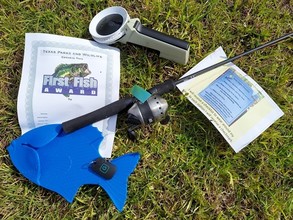
TPWD was contacted about helping to create more accessible materials to use at an event for people with vision impairment in Beaumont. After the event, Tera shared many ideas that were used in their "Accessible Fishing Day" event so others could gain from her experience.
This picture is a display of many of the items they used. You can see the braille labeler at the top of the picture. That gave them transparent tape with braille letters they put right over the top of the printed words on the certificate. Tera brought the labeler with her so they could add the name of each visitor, as well as their caught fish information directly to the award on that day. You can also see the tactile sticker they put on the casting button, so it was distinguishable from the other tools on the fishing pole. At the bottom is the wayfinder button they put on the backyard bass for the casting game (explained later).
|
|
USFWS "Jr Angler" certificates with braille are an example of how they used the transparent braille tape putting it over the certificate text. This is the National Park Service Jr. Angler Award. They also used braille tape for the "First Fish Award" from TPWD as you saw in the first picture above.
TPWD also provided a braille copy of a couple text items such as fish descriptions for display materials.
|
|
 |

"Beeping Fish Game" - The casting game with backyard bass was done as usual, except they added a beeping component. They purchased a wireless key finder device. It's a remote control with 8 switches. Each of 8 switches went on the back of 8 backyard bass fish. Then, when an individual would fish, they would click the buttons on the remote control. This made the switches make beeping noises and the individuals with a vision impairment, knew the location of the backyard bass.
|
|
Each backyard bass had a number on it that also had braille tape on it. This number corresponded to a trifold with several large print fish and information about the fish they caught. All of this printed information was also available in audio format accessed by a button by the card.
|
|
 |
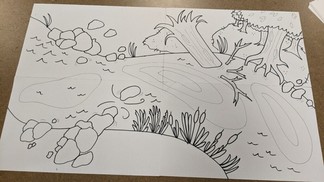
"Accessible Fish Habitat Mat" - This picture is only the second step of their completed mat. Unfortunately, it got pretty wet during the event, so Tera didn't get a final shot of the finished product. She had a volunteer who was a good artist, recreate the habitat mat on a piece of paper. Then, they used puffy paint to outline and create symbols within the areas of the habitat. (The common tactile graphic symbols can be found online.) There was a key on the bottom left of the map, so individuals knew what each symbol represented. Then, they purchased toy fish that decently represented each type of fish they discussed. It turned out really well.
|
Tera reports that the community in Beaumont was extremely excited to see the efforts they put in to making the event accessible to them. Unfortunately, a storm interrupted their event. People were really excited to come fishing with them that day and they are hopeful that it will be a sunnier day next time!!
(Photo credits: Tera Lynn Gray, USFWS)
Back to Top
by Dutch Baughman, FFI Education Committee Chairman and TPWD Angler Edu Area Chief
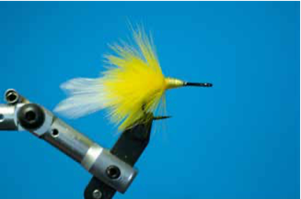
Fly Fishing International is the non-profit umbrella organization for fly fishing affiliates and clubs in the U.S. and other countries. The mission of Fly Fishers International is to foster the legacy of fly fishing for all fish in all waters through conservation, education, and inspiring a growing community of fly fishers.
The Fly Fishers International (FFI) Learning Center is a great resource for both novice and experienced fly fishers and is open to both FFI members and non-members. The Learning Center features current videos, manuals, and presentations for casting, fly tying, fly fishing skills, and conservation.
The FFI Learning Center has a wealth of educational and instructional resources that TPWD Instructors can learn from and use. New materials include the new Saltwater Fly Tying Manual, and eight new Casting Instruction videos.
Jerry Coviello and Ron Mayfield stated, “The Saltwater Fly Tying Manual was an initiative by the FFI Fly Tying Group to bring fly tying to "All Fish, All Waters". Seven expert authors were assembled from around the country within Fly Fishers International and they created a manual of twenty-three saltwater flies that could be used throughout the coastal states. Each author supplied step-by-step instructions with photographs on how to tie the fly plus background information about the pattern. The goal was to create a manual where tiers could download and learn the patterns and FFI clubs/councils could teach fly tying classes for saltwater patterns.”
|

Jim Sommercorn stated,“Eight new instructional videos have been added to the Fly Casting Video Library. Master Casting Instructors Bruce Richards and Dok Arvanites teach practical fishing casts and techniques useful for minimizing drag, changing casting direction, casting heavy flies and sink tips, dealing with obstructions and stuck flies, and for managing fly line while casting and fishing. Learning these casts and fishing techniques will add to your enjoyment of fly fishing and will surely improve your catch rate.”
Jim Sommercorn, Casting Board of Governors sub-committee is to review the Fly Casting Skills Development Program and the production of 8 new Casting Instruction videos.
|
Eight new Casting Instruction videos will be added to the existing Learning Center Casting Instruction including:
- Pick-up and Lay-Down Cast
- False Cast
- Roll Cast
- Fundamentals of a Cast
- Resources Needed to Give a Class on Basic Fly Casting
New materials scheduled to be added to the Learning Center include:
- Recordings from the FFI Online series
-
Youth Fly Fishing Education Program
- FFI 2021 Virtual Expo Workshop Recordings
-
Quill Body Flies
- The Fly Fishing Skills Program
TPWD provides Fly Fishing Instructor Certification for those with some fly-fishing experience to introduce the basics to youth and adults. However, the FFI Fishing Skills Program provides additional knowledge, skills and resources for individual fly fishers who want to further develop their skills or pursue formal training as an FFI Fly Fishing Skills Instructor.
Level 1. An opportunity for an individual fly fisher to explore, identify, and study fly fishing skills in the FFI Learning Center at their leisure.
Level 2. Fly Fishing Skills I: an opportunity for an individual fly fisher to participate in a formal Beginning Fly Fishing workshop during the FFI Virtual Expo.
Level 3. Fly Fishing Skills II: an opportunity for an individual fly fisher to participate in a formal Fly Fishing Skills workshop during the FFI Virtual Expo for experienced fly fishers.
Level 4. Fly Fishing Skills Instructor Development Program: an opportunity for an individual to participate in a two-day formal workshop designed to provide the teaching competencies in order to teach fly fishing skills (not connected to the Virtual Expo).
We hope that you will explore the wealth of resources available on the FFI Learning Center and encourage you to join a local Fly Fishing Club to meet others who enjoy and support the sport. Women might also consider joining Women Connect to network and learn from others across the nation!
(Photo credits: Top - Lemon Drop Tarpon fly by Ron Mayfield. Bottom by TPWD)
Back to Top
By Greg Akins, TPWD Angler Edu Training Specialist
The decision to use lures or bait when fishing is a matter of choice and based on what you want to catch. When fishing in saltwater, other things to consider include location, weather, tides, and the time of day. But, the key to catching fish is your presentation of the lure or bait.

Presentation
In most cases, we all want to catch the big one, so presenting the bait or lure correctly is key. However, to be able to catch the big one, you must have big bait or a big lure to make it look appealing to the “big one.” Make sure that the bait or lure is mimicking normal movements or is presented in distress, to draw the attention of the predator.
|
Live vs. Dead Bait
Dead bait such as shrimp or shad are commonly used when saltwater fishing -- however, hardhead catfish are notorious bait stealers (watch out for their sharp dorsal fins). When using live bait, such as shrimp or mullet, we find southern flounder or red fish like to hit them based on how they’re being presented. Although some may differ in opinion whether fish move because of hunger, smell, or instinct, everyone agrees that the bait presentation is what draws the fish to strike.
(Remember it is unlawful to use any game fish or part of a game fish as bait, and when using shrimp, it is required to be native to the Gulf of Mexico. For more information on regulations, check out "Bait Regulations" in the Outdoor Annual).

Lures
Most lures are designed to look just like the fishes’ favorite meal. Jigs, plugs, spoons, and soft plastics are all designed to mimic fish food. Of course, we never know what fish will hit our lines. What we do know is if the line and lure has a good presentation… we have a much better chance of catching fish.
Practice using the lures before going fishing with them. Most of the time you can see how top water lures are swimming at the surface, so you get the practice needed to present the lure correctly.
Lures designed for mid-levels of the water column, tend to work well for both bottom feeders and mid-level feeders. Since you may not be able see the lure's movements, trust your instincts and move them slow and steady. Many lures are designed by the manufacturers to do the job automatically but moving them too fast may distort how they're seen by the predator.
By dragging bottom lures, you’re bound to draw the attention of certain species such as southern flounder and black drum. If it tickles the top of a southern flounder or moves in front of a black drum, the likelihood of a catch is there - providing the presentation is appropriate and realistic.
For more information about baits and lures, check out our TPWD video on YouTube. For more information about saltwater fish, and some lures used, check out our TPWD video.
|

Three Things to Remember:
Decide which fish you are targeting, select the appropriate lure or bait, and practice your presentation beforehand. One thing I was taught many years ago by a good friend that I still have the privilege of fishing with is that there are three things to remember when catching fish in both salt and fresh water and that is: Presentation, Presentation, Presentation!
(Photo credits: Adam Comer, TPWD)
|
Back to Top
by Keira Quam, TPWD Angler Edu Training Specialist
|
Our Texas turtles need special help in the winter. When volunteering to teach fishing or just spending time outside, it is important to remember to be safe during the cold winter months.
-
Hypothermia is caused by prolonged exposures to very cold temperatures. When exposed to cold temperatures, your body begins to lose heat faster than it’s produced. Lengthy exposures will eventually use up your body’s stored energy, which leads to lower body temperature.
Body temperature that is too low, affects the brain making the victim unable to think clearly or move well. This makes hypothermia especially dangerous, because a person may not know that it’s happening and won’t be able to do anything about it.
While hypothermia is most likely at very cold temperatures, it can occur even at cool temperatures (above 40°F) if a person becomes chilled from rain, sweat, or submersion in cold water.
-
Frostbite is a type of injury caused by freezing. It leads to a loss of feeling and color in the areas it affects, usually extremities such as the nose, ears, cheeks, chin, fingers, and toes. Frostbite can permanently damage the body, and severe cases can lead to amputation (removing the affected body part).
One way to demonstrate this to others is shown in the TPWD Angler Education Instructor manual on page 61 - conduct a hypothermia demo:
- Explain that cold water can affect a person’s judgement, strength,
and coordination.
- Fill a 5-gallon bucket with water and ice, drop 25-30 pennies in the
bucket. Place an empty jar in the bottom center of the bucket.
- Ask for 1-2 volunteers to place their hand and arm in the bucket for
2-3 minutes. Without removing their hands, ask them to pick up the
pennies and put them in the center jar.
- Discuss how the cold water affected their ability to quickly pick up the
pennies
Remember that in Texas, even in the summer, someone who is wet from swimming, sweating or falling in, can get chilled if the wind comes up.
Below are some reminders of how to avoid, spot and treat hypothermia by the CDC.
|
 |
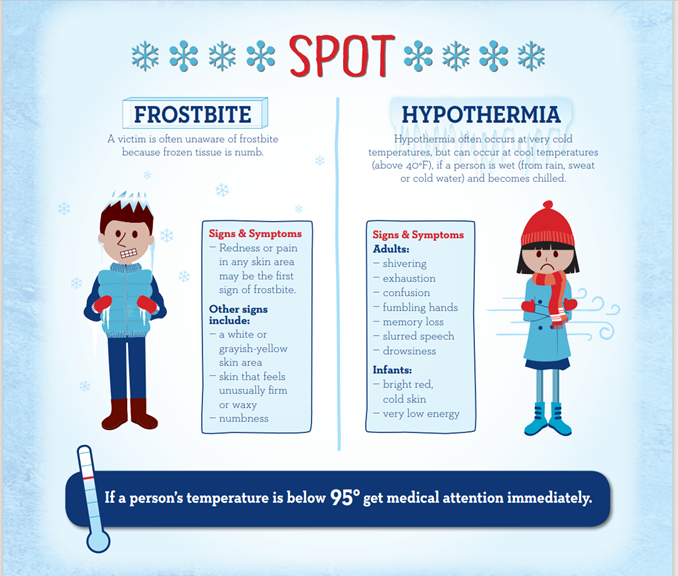 
Back to Top
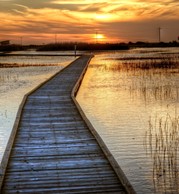
Have you ever watched the TV show, What Would You Do? The show depicts what people do when faced with a dilemma.
As we explain to our students in our fishing classes and events, and in our Basic Guide for the Beginning Angler, ethics are the rules or values you use to help you choose behavior that is fair to others and to yourself.
Ethics not only apply to fishing, but also apply to your role as a volunteer instructor.
At a recent volunteer management training conference, staff attended many sessions, including safety and ethics. Although we noted places where we could improve, we were pleased that many ideas presented are already in place for our Angler Education program as outlined in the new Instructor Guide.
Highlights from the Angler Education Instructor Guide include:
- Maintain the dignity and integrity of TPWD with the public as you teach. (page 9)
- Fundraising or seeking donations may NOT be done as a representative of TPWD or on behalf of TPWD. (page 10)
- Never be alone with a child. Always have another trusted adult to help supervise children. (page 81)
- All instructors and volunteers must self-report either online (preferred) or on the volunteer roster provided at a class or event. Lead volunteers cannot write in the hours on behalf of another volunteer. (page 88)
We trust you, our Angler Education Volunteer Instructors, will always choose the right path.
(Photo credit: TPWD)
|
Back to Top
By Karen Marks, TPWD Aquatic Edu Manager
Happy New Year! I hope that you were able to spend some quality time with family and friends over the holidays, and maybe squeezed in some time for fishing too.
It has been a busy fall and winter! In late September, our team had the privilege to attend the 14th biennial Aquatic Resources Education Association (AREA) national conference in South Dakota. The conference provides professional development training and networking for aquatic educators from state, federal and non-profit agencies.

At the conference, TPWD’s Aquatic Education Program received the Roland Sigurdson Outstanding Aquatic Education Program Award for the work done by both the Angler Education Program and the Texas Waters/Aquatic Science Program.
The Steve Campbell Outstanding Aquatic Educator Award was presented to Keira Quam, TPWD Aquatic Education Training Specialist. This award had special meaning for Keira because Steve Campbell trained her as a volunteer instructor long before she came to work for TPWD. It was an honor for the Aquatic Education team to be recognized for these national awards and a great way to cap off our 30th program anniversary.
Here at TPWD, we said farewell to our branch Outreach and Education Director, Johnnie Smith in November, and also to our agency Executive Director, Carter Smith in December. They will both be missed! Rob Owen (former TPWD Outreach and Recruitment Manger) has been hired to take Johnnie's position. Carter wrote a wonderful article in the December issue of the TPW Magazine – if you do not subscribe to the magazine, you can view the article online. In the January issue, meet our new agency Executive Director, David Yoskowitz, Ph.D. who comes to TPWD from the Harte Research Institute for Gulf of Mexico Studies. Like Carter, he is an avid outdoorsman, and we look forward to supporting his vision for the agency.
|

In mid-November, all actively reporting instructors received their incentive package that included the recently revised Instructor Guide. The guide is available online. Our Angler Education program brochure also has a new look, thanks to our summer interns who helped jump-start that project! The Basic Fly-Fishing booklet has been reprinted and now includes pages on regulations and ethics. We also have restocked the Freshwater and Saltwater Fish Pocket ID books.
We had a successful year this past fiscal year thanks to all of YOU! The annual report is available online – a shout-out to Area Chief Juan Urbano (Houston) for the cover photo.
Looking forward, we want to hear from you about Spanish language literature and resources -- please take the short survey by January 31st.
Don’t forget to check out our two new newsletter segments, "Safety Sense" and "Ethics: Doing the Right Thing".
|
Back to Top

TPWD Staff and Area Chiefs (volunteer Train-the-Trainers) trained 232 new instructors from July to December 2022. Go to the website to check out the list and welcome our New Instructors!
If you're an Area Chief and interested in learning to teach certification workshops online, contact TPWD Angler Ed staff for more information.
(Photo credit: Texas Parks and Wildlife - Texas Angler Educators Facebook page)
Back to Top
Angler Education Program | Texas Angler Educators Facebook | GoFishTX - Instagram | Learn to Fish Videos | Texas Aquatic Science | TPWD Fishing Information | Volunteer Portal | In Memoriam | Staff Contacts
Angler Education Instructor Workshops, Fishing Events, Fly Fishing Events, Texas Freshwater Fisheries Center, Sea Center Texas, Centennial Events
|